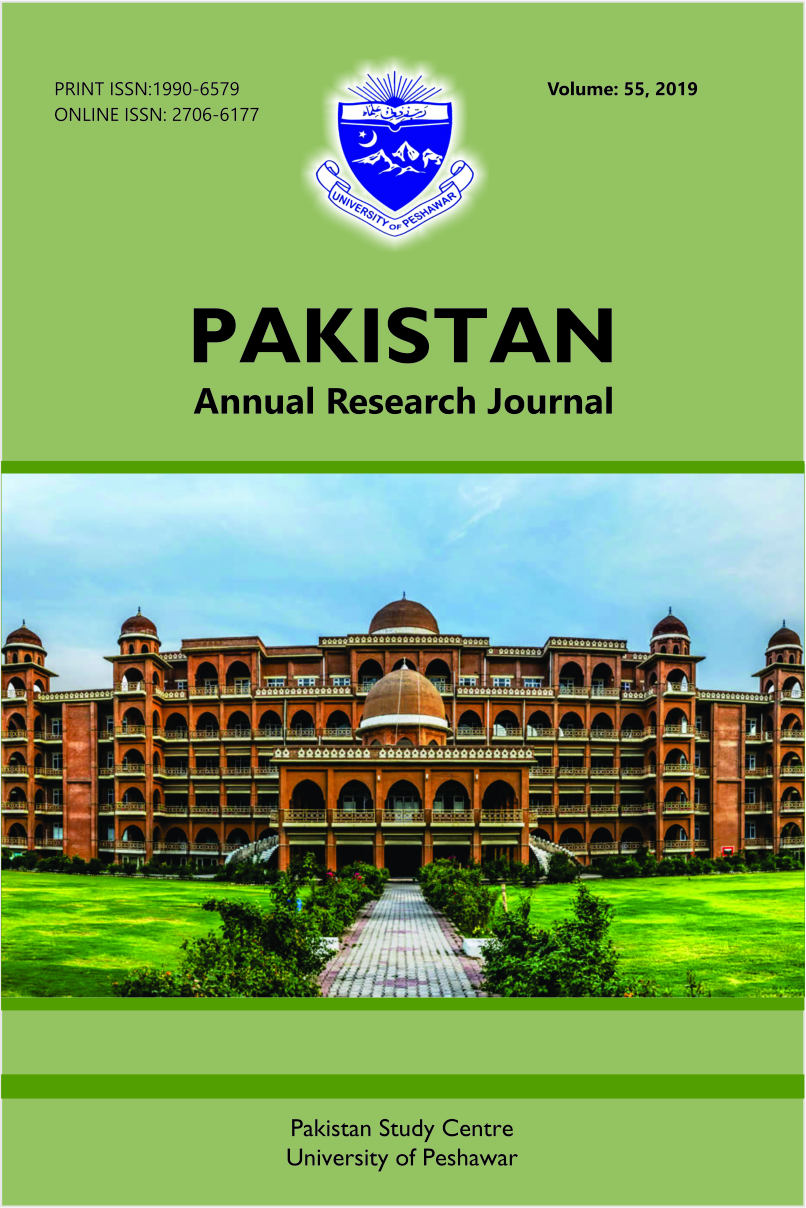IDYLLIC STYLES OF PEACE RESTORATION: A CRITICAL APPRAISAL OF COUNTER INSURGENCY IN WAZIRISTAN
Keywords:
War against terror, Counter insurgency strategy, Waziristan, winning hearts and minds, Operation Rah e Nijat, Zarb e AzbAbstract
Operation Enduring Freedom launched to punish the perpetuators of 9/11 was soon spilled into Pakistani tribal areas. Thousands of militants from Al Qaida and other groups converted the areas into their strong hideouts and jump-off points for exporting terrorism in Pakistan and Afghanistan. Pakistan committed its security forces to quell the insurgents in Waziristan in series of major and minor operations with mixed success rates. The research paper investigates the Pakistan counter insurgency operation insurgency and corresponding success of each major operation and factors responsible to their success or failure for the period from 2002 to 2018. The research nature is descriptive, mixing quantitative and qualitative components for contents analyses. The research found that first phase of the counter insurgency operation (2002-2009) did not pay dividends as envisaged. Counter Insurgency strategy of phase II (2010-2018) tailored on the lessons learnt proved to be promising with unprecedented results. The research concludes that hallmark of Phase II strategy were clear, hold, and build and succeeded in winning hearts and minds of the population.
References
Bundt, T. S. (2012). Counterinsurgency in Pakistan. Military Review, 92(4), 81.
Christine Fair, C., & Jones, S. G. (2009). Pakistan's War Within. Survival, 51(6), 161-188.
Christian Tripodi, (2008) “Peacemaking through Bribes or Cultural Empathy? The Political Officer and Britain’s Strategy towards the North-West Frontier, 1901– 1945,” Journal of Strategic Studies, 31: 1, 123–151.
Clausewitz, Carl Von (1976) On War. Edited and Translated by Michael Howard and Peter Paret. Princeton, NJ: Princeton University Press
David Montero (2006, June 22).
. Christian Science Monitor.
Dawn. June, 21st, 2009,
Fine, W. E. (2010). Winning the Hearts and Minds in
Counterinsurgency (Doctoral dissertation, University of Kansas).
Galula, D. (2006).Counterinsurgency warfare: theory and practice.
Greenwood Publishing Group.
Waziristan"
"Killing scares media away from "Troops make gains in Swat and South Waziristan".
Guerara, Che (1998) Guerrilla Warfare. Lincoln, NE: University of Nebraska Press, 1998.
Khattak, T. M. (April, 2015). Operation Zarb-e-Azb: An Overview. Current Affairs. Retrieved on 9. July 2019
Kilcullen, David.(2005) “Countering Global Insurgency: A Strategy for the War on terrorism”. Journal of Strategic Studies. 28: 597-617
Mao Tse-Tung.(1961) On Guerrilla Warfare. Translated by Samuel B. Griffith II. Champaign, IL: University of Illinois Press
Nation, Pakistan, May 20, 2006
Javed, U. (2015) ). Operation Zarb-e-Azb: A Successful Initiative to Curtail
Terrorism. South Asian Studies (1026-678X), 30(2).
Javaid, U. (2016). Zarb-e-Azb and the State of Security in Pakistan. Journal of
the Research Society of Pakistan, 53(1).
Jones, S. G., & Fair, C. (2010). Counterinsurgency in Pakistan. RAND
Corporation.
Kilcullen, D. J. (2006, September). Three pillars of counterinsurgency. In US
Government Counterinsurgency Conference (Vol. 28).
Kilcullen, D. (2013). Three Pillars of Counterinsurgency. Remarks delivered
at the US Government Counterinsurgency Conference, Washington
DC, 28 September.
Kimbrough, I. V., & James, M. (2008). Examining US Irregular Warfare
Doctrine(No. AFIT/ILM/ENS/08-04). Air Force Inst of Tech
Wright-Patterson Afb Oh School of Engineering And Management.
McCormick, G. H. (1987). The shining path and Peruvian terrorism. The
Journal of Strategic Studies, 10(4), 109-126.
Mullick, H. A. (2009). Pakistan's security paradox: Countering and fomenting
insurgencies (No. JSOU-09-9). JOINT SPECIAL OPERATIONS
UNIV HURLBURT FIELD
Owen Bennett Jones (2002) Pakistan: The Eye of the Storm, New Delhi: Viking, p. 2.
Paul Dixon. “Hearts and Minds?: British Counter-Insurgency from Malaya to Iraq.” Journal of Strategic Studies. 32: 3, 362
Pervez Musharraf, (2003) In the Line of Fire: A Memoir, New York: Simon & Schuster, p.201
Sattar Abdul (2009) Pakistan’s Foreign Policy 1947-2009: A Concise History, Karachi: Oxford University Press, 267-268.
Shuja Nawaz, Crossed Swords: Pakistan its Army, and Wars Within (Karachi: Oxford University Press, 2008), 541-542.
Shuja Nawaz (2009) FATA—A Most Dangerous Place: Meeting the Challenge of Militancy and Terror in the Federally Administered Tribal Areas of Pakistan, Washington, D.C.: Center for Strategic and International Studies, p. 34.
Zaffar Abbas (2005) ‘Operation Eyewash’, Herald, August, p. 64.
Zahid, Farhan. (2015). The Successes and Failures of Pakistan’s Operation Zarb-e-Azb. The Jamestown Foundation.
Powell, J. M., & Thyne, C. L. (2011). Global instances of coups from 1950 to
: A new dataset. Journal of Peace Research, 48(2), 249-259.
Shehzad, H., Raza, A., & Ghauri, Z. S. (2016). Conflict Resolution:
Editorialization of Government-Tehreek-i-Taliban Pakistan
Dialogue. Global Regional Review, 1(1), 24-34.
Yamin, Tughral. (2015)"Examining Pakistan’s Strategic Decision to Support the US War on Terror." Strategic Studies 35, 2
Zaffar Abbas (2005) ‘Operation Eyewash’, Herald, August, p. 64.
Zahid, Farhan. (2015). The Successes and Failures of Pakistan’s Operation Zarb-e-Azb. The Jamestown Foundation.





